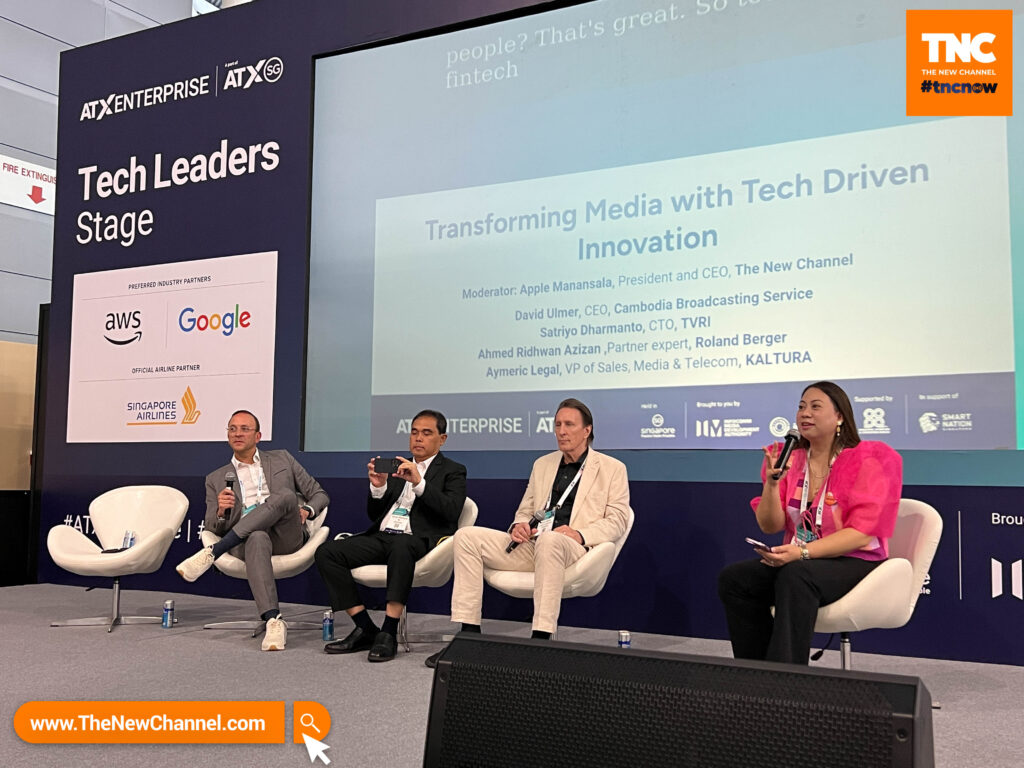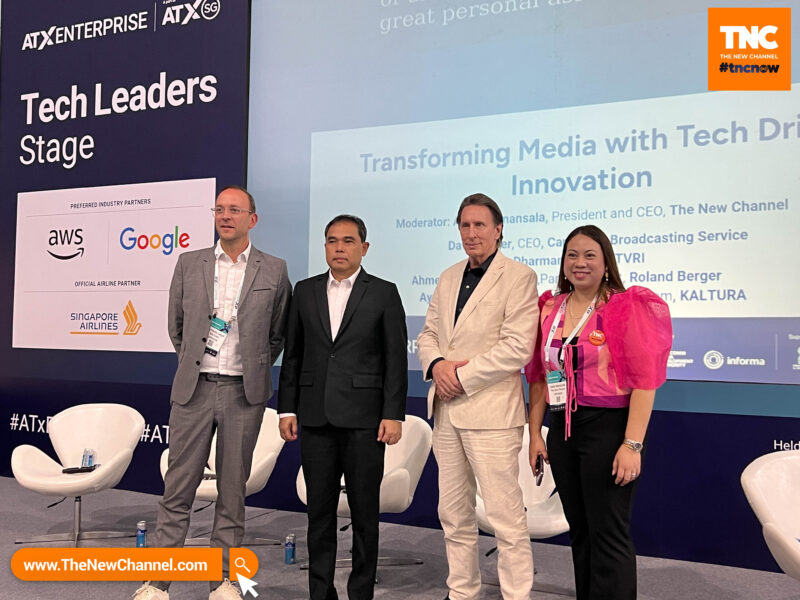At the Enterprise stage at AsiaTech SG, the session Transforming Media with Tech Driven Innovation featured David Ulmer representing the US and Cambodia, Aymeric Legal representing France, and Satriyo Dharmanto representing Indonesia. The Philippines’ own Apple Manansala, President and CEO of The New Channel moderated the session.
The discussion centered on the integration of AI in media and content creation. The panellists agreed on the complementary nature of AI and human creativity, stressing the need for training and upscaling human resources. Discussion also touched on the regulatory challenges and the importance of adapting to evolving consumer habits.

Below are synthesized talk points from the esteemed panellists.
Satriyo Dharmanto, Chief Technology Officer, TVRI Nasional
- AI-Enhanced Content Creation and Management
AI is being used to script videos, improve content diversity and quality, upgrade old media to HD, and manage massive content libraries through automated archiving and metadata tagging. - Localized and Inclusive Content with AI
AI powers localized storytelling through avatars, dialect-specific content, and region-based facial representations—bringing news and entertainment closer to diverse local audiences. - Personalized Audience Engagement
Through audience profiling, AI enables tailored advertising and content delivery—aligning supply with demand and deepening viewer relevance and retention. - Empowering, Not Replacing, the Human Workforce
AI is treated as a support system. Upskilling and collaboration ensure human talent remains central to creative and operational processes. - Bridging Traditional and Emerging Media Platforms
AI supports both new digital experiences and traditional linear channels, ensuring content accessibility even in remote areas with limited connectivity.
Asked about a major difference between traditional media and new media, Dharmanto stressed monetization, citing, “Linear channel is little bit impossible to use profiling the audience. But, for the new media, normally, we are profiling the audience when they join then we can give the advertising based on the what the audience needs, like a customization. How to manage between supply and demand, for example, me, I like sport, for example, so, the advertising is related to what I need.”
Aymeric Legal, VP, Sales and Marketing of Kaltura
- AI as a Creative and Developmental Accelerator
AI is used to enhance, not replace, human work—driving faster innovation in software (e.g., 30% of Microsoft’s code is AI-generated) and content creation. - Smarter, More Personalized Content Experiences
Practical AI applications include auto-chaptering, tone-preserving translations, mood-based recommendations, and dynamic engagement in live TV (e.g., clips and highlights for social media). - Shaping User Habits and Engagement
AI helps build intuitive user habits and seamless content interaction, crucial for long-term customer loyalty and deeper digital engagement. - Adapting to Shifting Media Behaviors
Younger audiences demand short, interactive, and immersive content—requiring creators and platforms to stay agile and tech-forward. - Balancing Innovation with Responsible Regulation
AI policies should protect creators, ensure metadata and IP integrity, but avoid stifling creativity—ensuring AI remains a tool for empowerment, not limitation.
Aymeric Legal shared how channels must adapt to a changing audience, just as audiences shift viewing habits based on new media and technology. By using technology, and AI, they capture parts of the show from livestream to tease audiences with FOMO (fear of missing out) into watching the entire show.
According to Aymeric, “You need to capture audience from the social media. (What we do is) you have your live show, you extract the best moment of the show, you spread them on the social network. And AI is there to do automatic clipping. Then we bring back the audience because they watch the show, (and see what) will be interesting. So maybe I will watch the show on capture, and maybe next time I will sit down in front of my TV to watch the show. It’s a mix of livestream and social network all together.”
David Ulmer, CEO of Cambodian Broadcast Service
- AI as a Catalyst for Efficient Content Production
AI is transforming production by enabling cost-effective digital sets and streamlined multilingual broadcasts, making global content creation more accessible and affordable. - Shifting Platforms and Audience Behavior
Viewership is rapidly shifting from traditional TV to mobile platforms, especially among younger demographics (like Cambodia’s 13–25 age group), urging creators to adapt formats and delivery. - Smarter Product Integration and Sponsorship
There’s a push for more subtle, authentic brand placements and dynamic sponsorships—using AI to localize logos and messages per region without disrupting the viewer experience. - AI and Workforce Evolution
AI isn’t replacing jobs outright, but it’s redefining roles. Those who can effectively use AI will have an edge over those who can’t—emphasizing the need for digital upskilling. - Balancing Innovation with Creative Freedom
While AI opens creative possibilities, minimal regulation is preferred to avoid stifling innovation. The emphasis is on keeping creativity unconstrained while using AI responsibly.
Ulmer brims with experience being both Western (the US) and Eastern (Cambodia) straddling two seemingly polar cultures. Discussing content creation and niche audiences, Ulmer says, “There’s a little bit of danger in trying to guess who your audience is. Over the years, 50s and 60s, as television evolved, it was the content creators that were defining who the audience was (…) with all these different shows that are promoting kind and thoughtful family life, even if family life wasn’t that way. (Today) we’re in a world now where the audience decides what they want to watch. There are so many choices, 1000s of pieces of content coming from Netflix and HBO and Amazon Prime and the broadcasters, and basically, we leave it up to the audience to figure out what they want to watch. I think the challenge for us as a content creator is, how do you address all of that? You can’t micro target and create 1000 different shows. You have to create a single show, and hopefully it has a good audience, a broad audience for your demographic.”
For more NEW stories, search #TNCnow or read thru 💬 https://thenewchannel.com/highlights/
Check out 🌐 https://www.TheNewChannel.com/
#onTNC #AsiaTechSG #MediaInnovation #TechMeetsMedia #TheNewChannel


